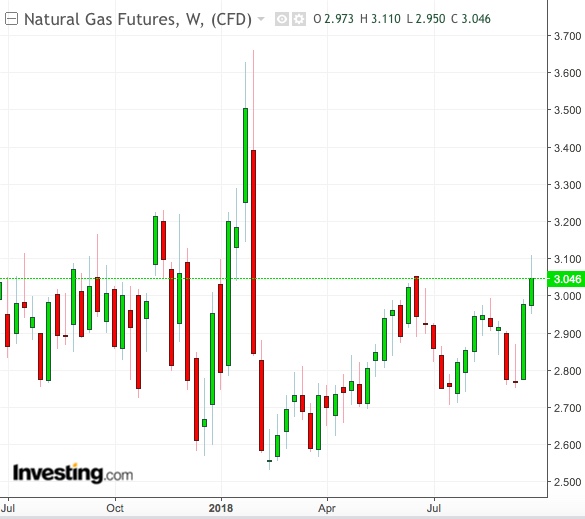If ‘The Ballad of East and West’ was recast for the natural gas market, the opening line would probably read: “Oh, Production is Production, and Storage is Storage, and Never the Twain Shall Meet!”
In one of the most extraordinary scripts playing out on the smallest energy market in the United States, output and stockpile numbers are at odds with each other. And there’s chance the two may not reconcile for a while, to the delight of natural gas bulls.

In Thursday’s session, natural gas futures for November delivery on the New York Mercantile hit 14-month highs of $3.111 per million British thermal units. But its settlement at $3.056 per mmBtu was just moderately higher than the market’s 2017 close of $2.953, translating to a year-to-date return of 3.5 percent.
Record Production
Analysts said prospects for natural gas would be bearish if considered from just its record high production, which the US Energy Information Administration expects to reach 81.34 billion cubic feet per day this year from 73.57 bcfd in 2017.
But the picture turns bullish if they add to the mix one of the lowest pre-winter heating stockpiles in a year, thanks to the unusually high volumes of gas burnt by utilities this summer to feed power demand for air conditioning.
“It will be difficult for prices to maintain the recent elevated levels with easing (of) demand expected over the next few weeks,” Daniel Myers, natural gas analyst at Gelber & Associates in Houston, Texas, said in a commentary on Thursday. Though he added:
“However, the market has grown tired of the promise that record production will be enough cover the difference in storage this winter without the results to back it up...The onus is back on supply to prove itself through undeniably large storage additions.”
Supply Has To Prove Itself
And gas storage failed that test again in the EIA’s weekly data issued on Thursday.
Utilities injected 46 bcf into storage last week, the data showed, against a 86-bcf injection in the previous week. That was nearly a third below the 64-bcf addition expected by analysts. More importantly, the latest storage hike once again fell under the five-year average of 81 bcf for weekly injections—a target utilities have been struggling to meet since the start of summer, as homes and businesses required more cooling than expected from sweltering temperatures.
Dominick Chirichella, director of risk management and trading at the Energy Management Institute in New York, said:
“With most of the injection season already in the history books it seems almost certain inventories at the start of the winter heating season will be anywhere from 15 to 20 percent below normal.”
EIA data showed working gas in storage totaled 2,768 bcf versus a the five-year historical range of 3,389 bcf typical for this time of year.
“Strong Buy” From A Technical Perspective
Investing.com’s daily technical outlook has a “Strong Buy” on NYMEX gas, with no meaningful sell targets for now.
Despite this, not all factors are in favor of gas.
Chirichella points to the potential for an El Nino weather phenomenon during the winter, which could make surface waters in the central and eastern Pacific Ocean significantly warmer. This could reduce the need for heating and offset some of the pressure placed on the current low gas inventories.
Near-Term Weather Could Deal A Blow To Bulls
The eight to fourteen-day weather forecast is also less supportive than previously, signaling that cooling-related demand could decrease in the coming weeks.
Technically, NYMEX’s November gas could return to its Sept 7 bottom of $2.759 to reenergize “and chances are good that another upswing to $3.100 is around the corner”, markets chartist EWM Interactive said. The firm said:
“After that, however, a bearish reversal should be expected, since every impulse is followed by a three-wave correction in the opposite direction."
“Whether it will be just a small pullback or a larger decline is yet unknown, But traders should know that the price of natural gas carries a lot more risk for their long positions now than it did two weeks ago near $2.830.”
Technicals aside, if weekly stock injections don’t pick up and production falters, then $3 per mmBtu—or above—could become the norm for natural gas.
Gas bulls have already done a remarkable job in keeping the market at that level this late into summer, although volatility has chipped away at annual gains.
